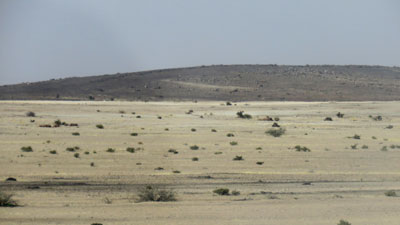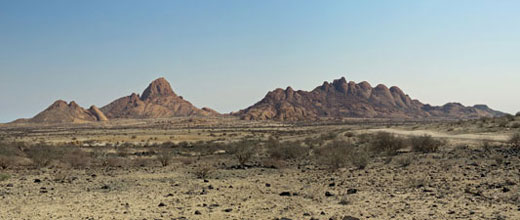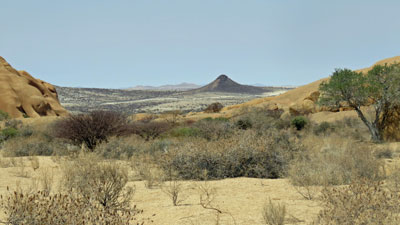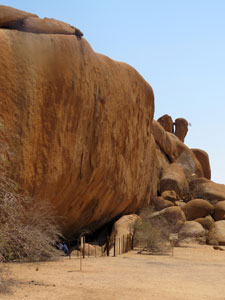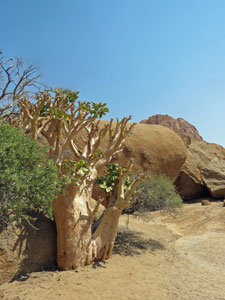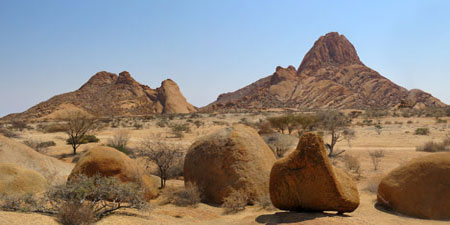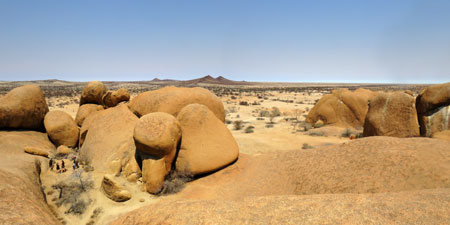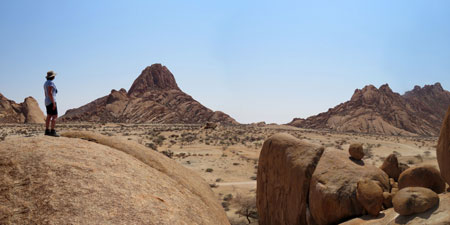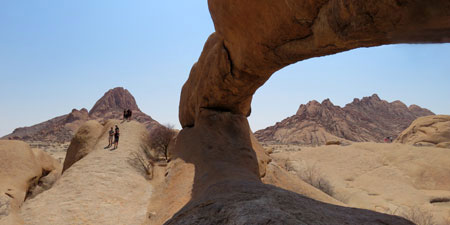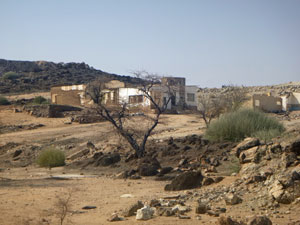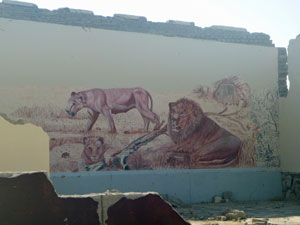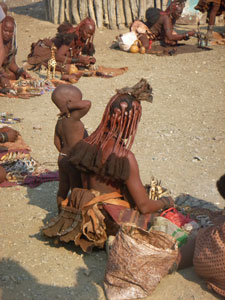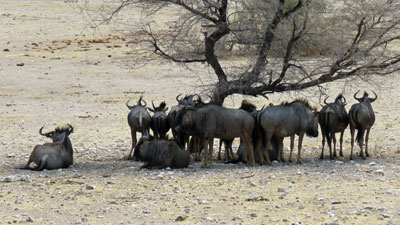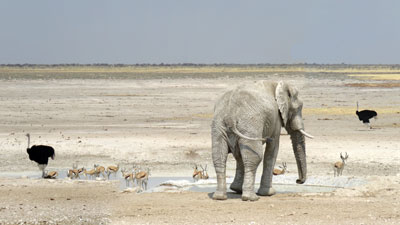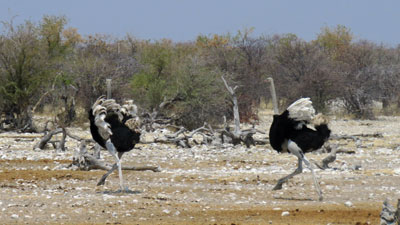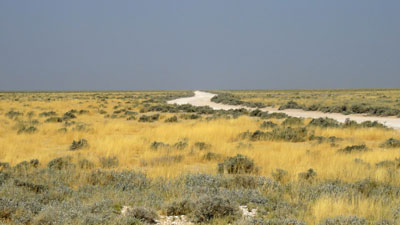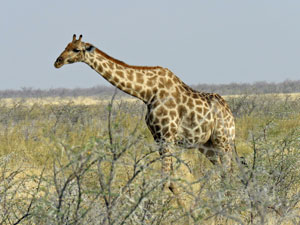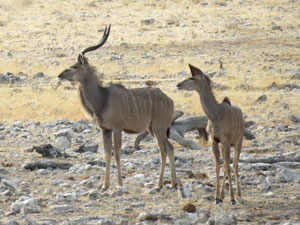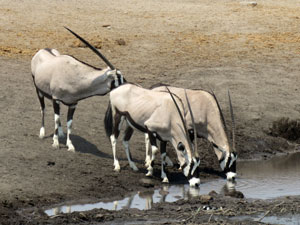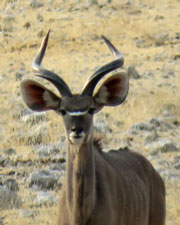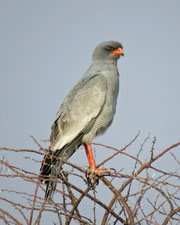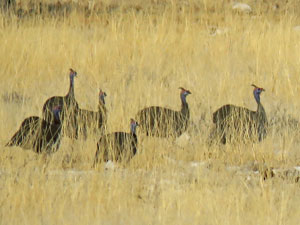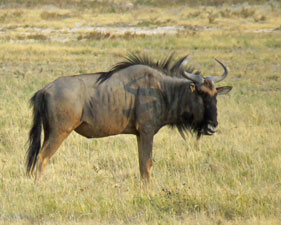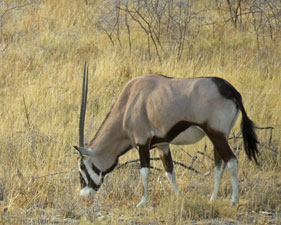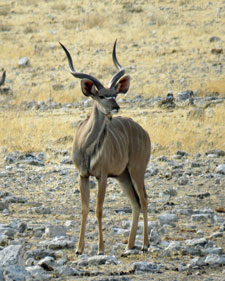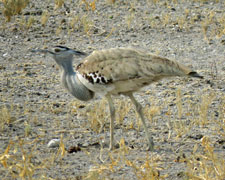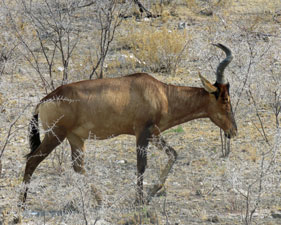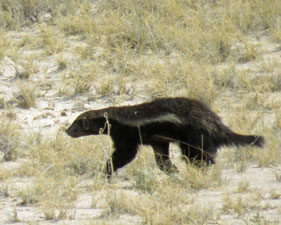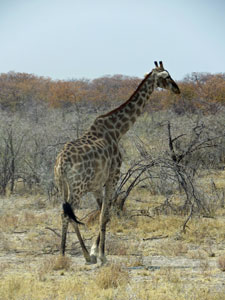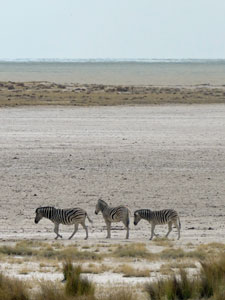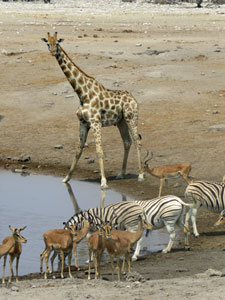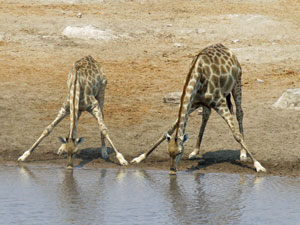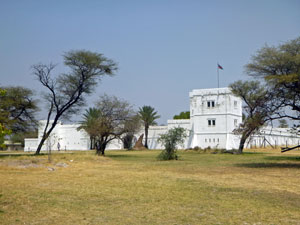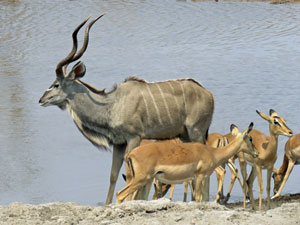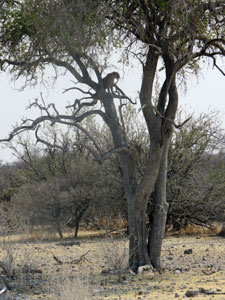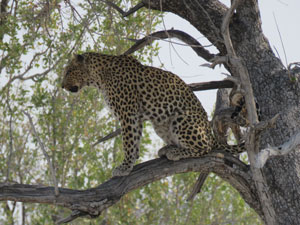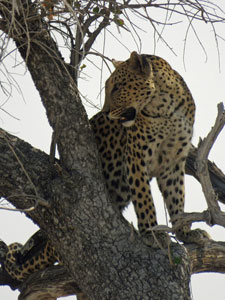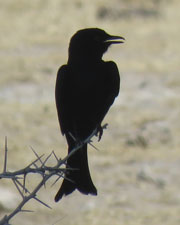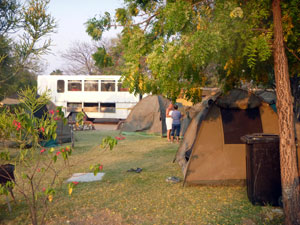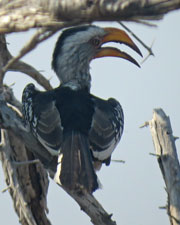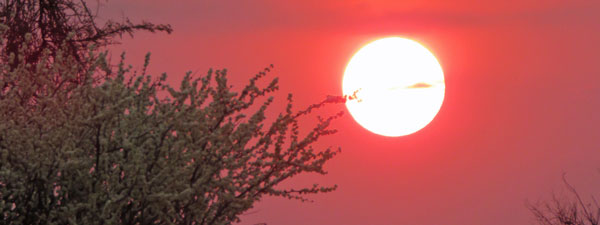| African Safari - Namibia (part 2) |
Day 8 - Swakopmund to Khorixas (or not) |
|
|
|
Once there, we took a short walk around the base of the pinkish-orange rock formations with Dennis, a Damara guide. He explained some of the practices of the San people and showed us an overhang with their rock art, dated from 2000 to 4000 years ago. |
|
|
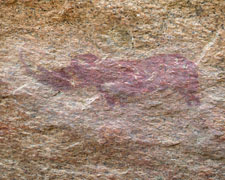 2000 year old rock art ... |
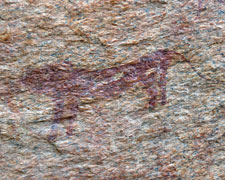 ... painted by San bushmen |
||
A wander amongst the giant boulders and fascinating rock formations completed our visit to Spitzkoppe and it was well worth the detour. |
||
 |
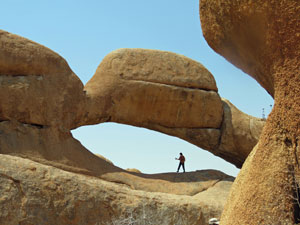 Landscapes of Spitzkoppe |
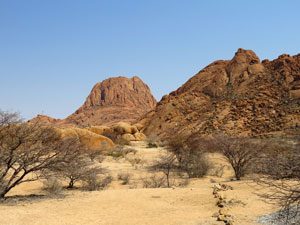 |
|
|
Retracing our route to the main road, we soon turned again to follow a wide gravel road across the desert, passing dry stream beds and mining ghost towns on the way. Our destination was Khorixas, some 200 km away - Sonny the truck, however, had other ideas, and 40 km on the fuel line problem reappeared and the truck ground to a halt, starved of diesel. Justice and Jojo cleaned and primed the fuel pump and away we went again .... this time for another 10km before coming to another desert breakdown. The exercise was repeated twice more, with ever decreasing distances gained, by which time we had lost two hours. |
|
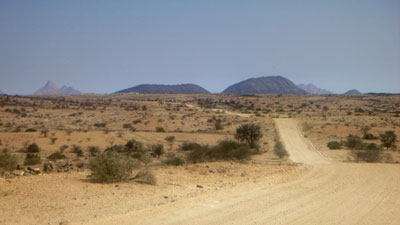 The road through the desert |
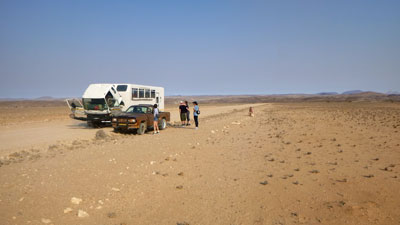 Sonny the truck breaks down ...... again |
|
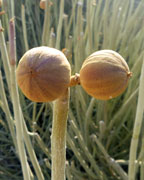 |
|
It was time for Justice to "phone a friend" and, 30 minutes later, the diesel mechanic arrived from the little town of Uis, 25 km away. The sun set - a glorious orb of red, glowing softly through the encroaching sea-mist - above the immense desert landscape, as they stripped and cleaned all the fuel lines. |
 Namib desert landscape |
 Evening colours through a misty sky |
At 7.30pm, to a loud cheer, Sonny's diesel motor roared back into life and we headed off again. With Khorixas well over an hour away, Justice decided to head into Uis, where we set up our tents at the comfortable Brandberg Campsite. It was certainly better than pitching our tents on the side of a lonely desert road. |
|
|
Day 9 - Uis to Opuwo |
Unfortunately, the time lost due to breakdowns meant an early start to catch up, though not before another visit to the mechanics to verify and finish the on-road repairs. Instead of the planned 7.30am departure, we left at 8.45am, which enabled a bit of a catch-up on emails and world affairs on the campsite wifi. Finally, a revitalised Sonny cranked up, with Justice at the wheel, and we headed north once again as the silhouette of the Brandberg Massif (at 2570m the highest mountains in Namibia) slipped quietly into the distance. |
||
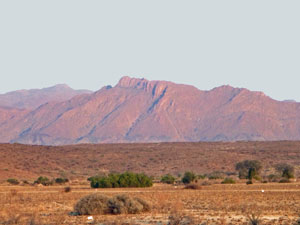 The Brandberg Massif - highest mountains in Namibia |
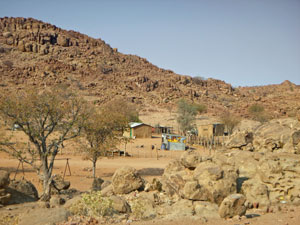 Himba roadside settlement |
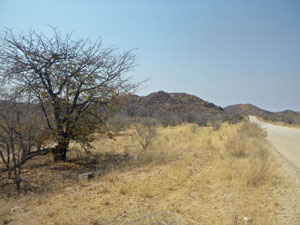 Entering thorn-tree country |
It was a long day on the road - the first 200km on a wide and straight gravel road that enabled us to gain some time. As we did, we slowly left the plains behind and entered a desolate landscape of rounded hills, their slopes covered with bare or dry-leafed trees. The ways of dealing with the lack of water in the desert are many. |
The town of Khorixas (where we were originally going to stay) came and went and, before long, we reached Kandajab - time to stop for lunch under the shade of an enormous thorny acacia, its yellow puff ball blooms a sign that, somewhere deep below, its roots had tapped into water. Passing through more dry-vegetated hills north of Kandajab, the landscape gradually flattened again, but this time there was an increasingly green cover of scattered scrubby trees and shrubs, and even some grasses. This was grazing country and we zipped by several small communities of huts and goat-herds. By the time we reached our destination of Opuwo, its buildings sprawled across a dusty plain at the base of arid thorn-tree scattered hills, we were ready for a rest. |
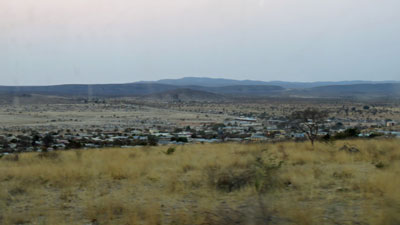 The hot dry landcape of Opuwo |
That, however, was not to be, as we had no sooner arrived at the luxury Opuwo Lodge Hotel and campsite, than we bundled in to a 4WD safari truck to head a further 20 bumpy kilometres out of town. The dust haze hung low and isolated dust-devils formed, swirled and disappeared on the plain. Desolate surrounds indeed, as we reached our destination of a traditional Himba village to learn something of their culture and way of life. |
|
|
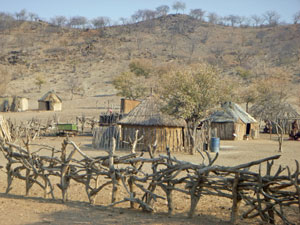 Himba village |
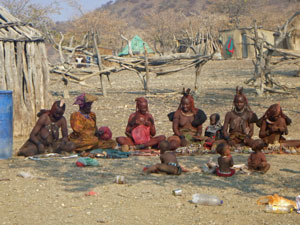 The ladies gather to sell their wares |
|
The visit and travel took about 90 minutes and it was a relief to get back to camp and finally relax - sometimes all the culture you need is an ice cold beer.
|
||
|
Day 10 - Opuwo to Etosha National Park |
The trip to visit the Himba village had been a long detour and today we had to retrace more than 200km to get back on to the main route. However, our reward was to be our first opportunity to see some of the iconic African wildlife close-up. After another 80 km of driving through flat country with low scrubby trees, a sparse ground cover of grasses and several big cattle properties, we entered the Andersson Gate of Etosha National Park. Established in 1907, this park of over 22,000 km2 protects hundreds of species in desert, grassland, savannah and woodland habitats. |
||
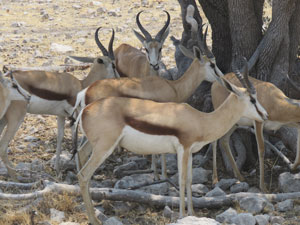 Springbok taking a mid-day rest |
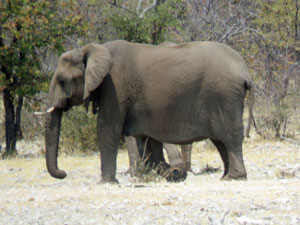 Our first elephant in Etosha |
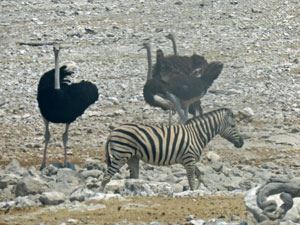 Zebra with ostriches |
Let the game-watching begin! Cruising from waterhole to waterhole, with stops in between whenever some interesting wildlife appeared, we saw a wide range of African fauna - elephants, giraffes, zebra, wildebeest, kudu, springbok, impala, jackals, ostriches, secretary birds and bustards. The photos tell the story. |
|
|
|
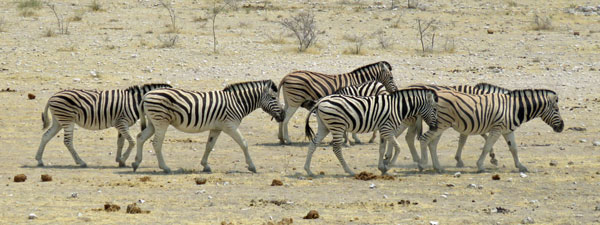 A herd of plains zebra |
|
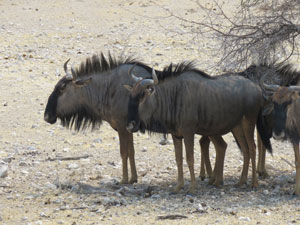 Blue wildebeest |
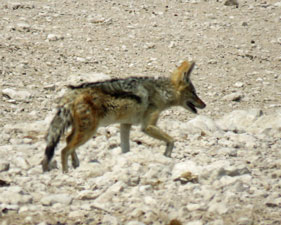 Brown jackal |
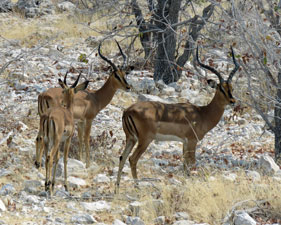 Impala |
|
|
|
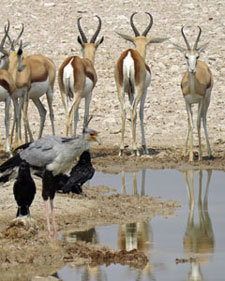 Springboks with secretary bird |
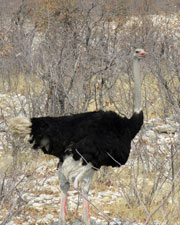 Ostrich on the alert |
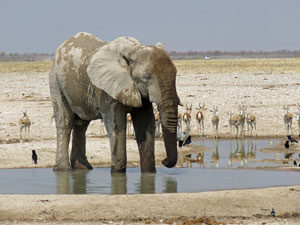 When the waterhole is small and the elephant large |
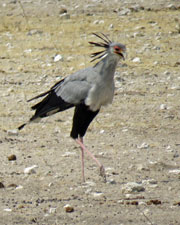 Secretary bird |
To add some cream to the cake, just before reaching our park camp at Halali, we came across one sleeping lion, plus two others on the move. It had been a very successful afternoon of game-watching. |
|||
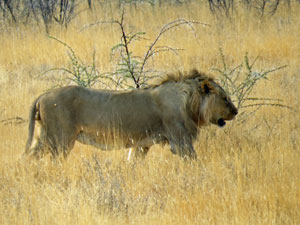 Lion on the prowl |
 Natural waterhole |
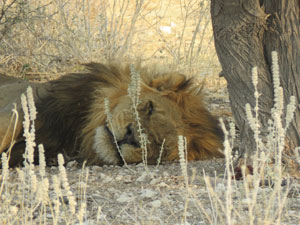 Snoozing lion |
Halali Camp was a very pleasant spot - a large area of shady trees and buildings fenced off - the wildlife roams free while we were all locked in for the night. Still, it was a civil place with a swimming pool to shake off the dust of travels and a bar to buy an ice-cold beer and watch the sun set - a red orb through the dusty haze. |
||
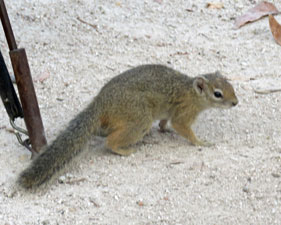 Camp site squirrel |
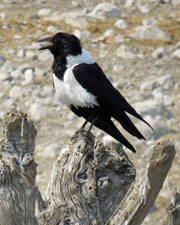 |
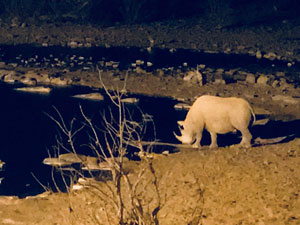 Rhino drinking at Halali waterhole (photo: P. Pan) |
Every campsite is located near a waterhole (just outside the fence), so, after dinner, the fair Nello and I wandered down to check it out ...... a couple of hyenas and a pack of jackals came and went, but the highlight was a pair of black rhinos quietly standing at the edge of the water and occasionally having a drink. We sat and watched in the pale light, transfixed. It was an Africa moment. |
|
Day 11 - Etosha National Park |
Today, the great Etosha game drive continued, as the sun rose red above the dusty horizon. The usual suspects were out in force - herds of zebra, wildebeest and springbok grazing in the grassy flats alongside the edge of the enormous Etosha clay pan. Elephants, giraffes, kudu and oryx made their appearance. As well, we increased the species count with a pair of honey badgers and some red hartebeest. Sadly, the prized quarry of a leopard eluded us. |
||
|
|
|
|
|
|
A drive out on to the salt-encrusted clay of the Etosha Pan, gave us a chance to get out of the truck and stretch our legs (leaving vehicles is prohibited elsewhere in this lion country). It also gave us a chance to appreciate the immensity of the pan's flat 4780 km2 surface. |
|
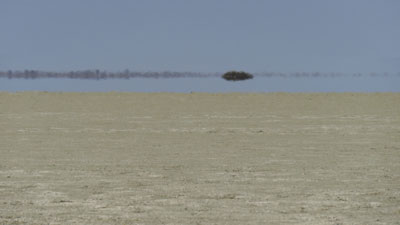 Mirage on the Etosha clay-pan |
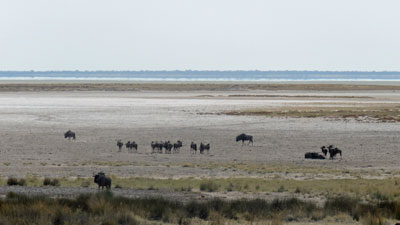 Wildebeest crossing the pan |
|
|
|
|
|
|
After lunch in the shade at Namutoni Camp, with its old German fortress, we continued the game-drive for a short while. Heading out into the hot afternoon (35°C) certainly proved worthwhile. While the springbok huddled in the sparse shade of the scrubby thorn trees, we chanced upon a waterhole where a herd of 11 elephants had just arrived to take a bath. After having a good soak and showering themselves, they emerged to give themselves a follow-up dust bath before leaving. Had we arrived 20 minutes later, we would have seen nothing more than an empty waterhole and a set of disappearing elephant backsides. |
|
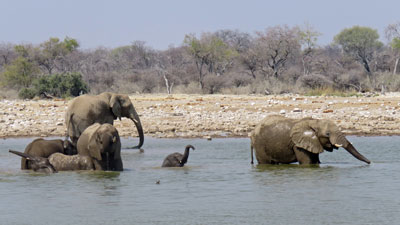 A herd of elephants taking their water bath ...... |
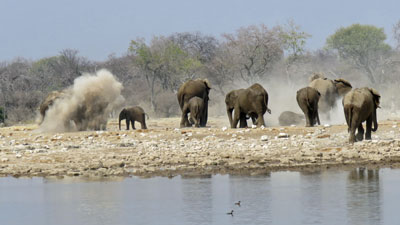 ..... followed by a dust bath |
|
We were not the only ones watching the waterhole. A few hundred metres away, from its tree-top vantage point, a leopard was keeping an eye on the comings and goings of the animals. I suspect that, tonight, there may be one less springbok in this world. Watching the leopard was a superb finale to our time in Etosha.
|
|
|
|
|
Our accommodation was just 20 km beyond the von Lindquist Gate, so no long drive at the end of the day - just the pleasant Sachsenheim Lodge, based on a farm with its gently-bleating goat herd, grassy tent sites, bar and pool. The dust of a long game-drive was quickly washed away. Thanks to Justice for the patient driving and Jojo for his great spotting of wildlife. As Justice would say - "happy days". |
||
|
Day 12 - Etosha to Windhoek |
A warm easterly wind was sweeping across the flat savannah landscape, as we packed up and headed south - the red African sun just clearing the horizon to silhouette the sparsely-leaved thorn trees. Today would be a long driving day - our destination, Windhoek, the capital of Namibia. |
At last we were back on good sealed roads and the 500 km journey seemed to pass fairly quickly, as we headed into greener landscapes, driving by a series of game ranches and giant termite mounds - up to 4m tall, the colours of red and cream revealing the soil type. |
|
 A land of very large termite mounds |
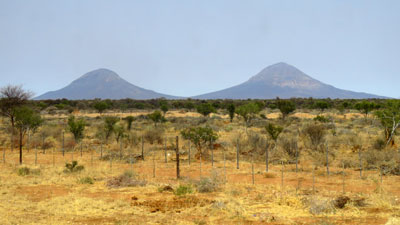 Game ranch country on the road to Windhoek |
Windhoek, itself, has a modern centre built around the old German colonial buildings. We only stayed for a couple of hours - long enough to do a brief guided tour of buildings that had a connection to Namibia's history - German colonisation, the genocide of 1904-08, South African occupation and apartheid and, finally, independence in 1990. It was a complex and fascinating story. |
||
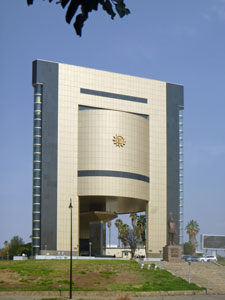 The 21st century Independence Memorial Museum |
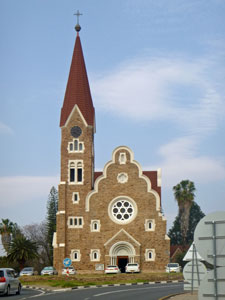 The 19th century German cathedral |
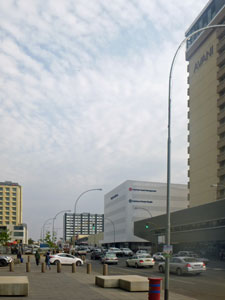 Windhoek cityscape |
Then it was on to our accommodation for the night - Heja Game Reserve, set in the rolling foothills of the mountains to the east of Windhoek. Here we also added baboons and warthogs to our growing list of animals observed, as well as being amused by the antics of a big flock of guinea fowl. |
||
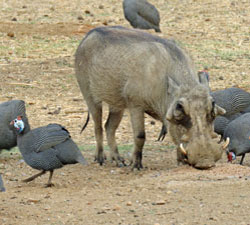 |
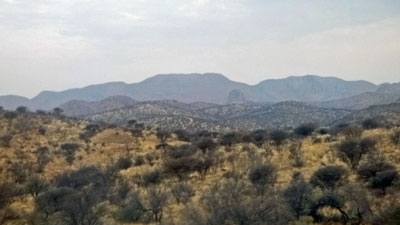 The mountains east of Windhoek |
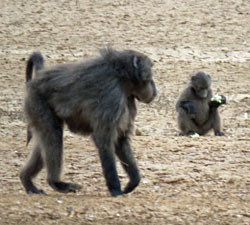 |
Tonight there would be no camping - we had own own rooms with real beds, accompanied by a feast of game-meats such as springbok and oryx that were farmed on the reserve (apologies to any vegetarians reading this). Best of all though was the bed. |
|

